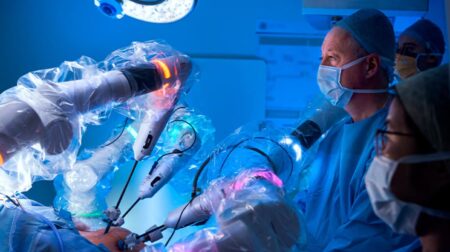North Bristol NHS Trust (NBT) and Bristol Robotics Laboratory at the University of the West of England (UWE) are collaborating on the development of robotics and other healthcare technology to improve patients’ health and hospital experience.
Under the NBT/UWE Health Technology partnership, NBT will consider how emerging technologies, such as AI, machine learning, and socially and physically assistive robots, could be used to better support patients at Southmead Hospital in Bristol.
It will also trial technology with patients and care staff, leverage benefits of shared facilities, and support and facilitate joint research and learning.
Southmead Hospital is currently considered one of the most technologically advanced in Europe, with robots conducting cancer surgery, dispensing pharmacy medicines, transporting supplies, and analysing blood samples.
However, the introduction of socially assistive robots could give post-operative patients on Southmead’s wards personalised guidance to regularly eat, drink and exercise, helping them to recover physically and mentally in conjunction with their therapy team.
Robots connected to smart sensing devices could also be used to help patients recover in their own homes.
In future, they may also be able to assist nurses and doctors at Southmead when extra treatment or a visit is needed.
North Bristol NHS Trust clinical director for anaesthesia, surgery, critical care and renal, Tim Whittlestone, said: “We have an ageing population requiring ever more complex treatment.
“Technology gives our growing workforce massive opportunities to manage this and improve care.
“Robots can help us do some of the more mundane, repeatable tasks and free up staff to do what they do best – listening, thinking and caring.
“They can also analyse data, helping us to really personalise treatment, care and recovery.
“There are constant developments so we need work out how patients and staff interact with the technology and whether it’s useful.”
Southmead Hospital Charity recently funded a new second robot now conducting keyhole surgery for a range of cancers.
According to the hospital, this follows years of robotic prostate cancer surgery that has been more accurate, less invasive, caused less blood loss, and reduced hospital stay from three days to one.
Some 12 automated guided vehicles transport food, linen, medicines and other supplies around the hospital 24/7. Steered by GPS and operating lifts, they have reportedly quickened deliveries to wards and reduced injuries to porters.
Elsewhere, the hospital’s pathology lab uses automated technology to move and test blood samples, after they are transported underground via pneumatic tube from wards.
The hospital’s pharmacy also uses three automated robots to sort and select medicines for dispensing by pharmacists.
Clinicians are also exploring the introduction of an algorithm to predict seasonal variations in admissions to the Emergency Department, as well as AI-assisted reading of breast mammograms and decision-making on prostate cancer.
What’s more, the Bristol Robotics Laboratory team will seek joint funding to further develop assistive robotic systems such as CHIRON, which is being designed to support older adults with mobility and other ageing-related impairments.
Southmead Hospital staff will help shape the design and safety testing the technology, thus accelerating its development and ensuring it fits in with clinical procedures and practices.
It’s thought that the robot could eventually assist with anything from bringing a tray of food or drink to a patient on demand, to helping those with mobility issues to their feet and practise walking to aid their recovery.
Professor Praminda Caleb-Solly, leading research in assistive robotics and intelligent health technologies at Bristol Robotics Laboratory, said: “Hospitals are likely to be the first adopters of this type of technology so it will be beneficial to test our prototype in a hospital setting and work with hospital staff in shaping it.
“Through this partnership, we can have a more clinically-informed focus to our research and make it more relevant to the specific needs of the patients and NHS staff.”







